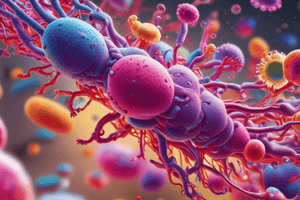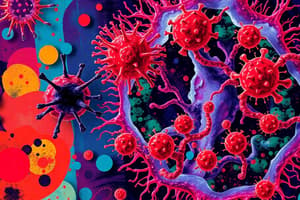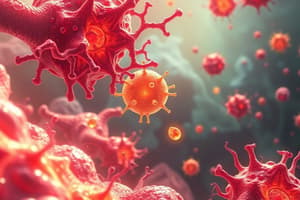Podcast
Questions and Answers
What is the role of adhesins in the context of virulence factors?
What is the role of adhesins in the context of virulence factors?
- They cause systemic inflammation.
- They break down host tissues.
- They stimulate an excessive immune response.
- They allow pathogens to attach to host cells. (correct)
How do exotoxins differ from endotoxins in terms of their stability?
How do exotoxins differ from endotoxins in terms of their stability?
- Both exotoxins and endotoxins are heat-stable.
- Exotoxins are heat-labile while endotoxins are heat-stable. (correct)
- Exotoxins are heat-stable while endotoxins are heat-labile.
- Both exotoxins and endotoxins are heat-labile.
Which of the following is an example of a membrane-disrupting toxin?
Which of the following is an example of a membrane-disrupting toxin?
- Cholera toxin
- Diphtheria toxin
- Botulinum toxin
- Streptolysin (correct)
What is the primary function of superantigens in the context of virulence?
What is the primary function of superantigens in the context of virulence?
Which statement correctly describes endotoxins?
Which statement correctly describes endotoxins?
What mechanism do viruses use for adhesion to host cells?
What mechanism do viruses use for adhesion to host cells?
Which of the following accurately describes antigenic variation in viruses?
Which of the following accurately describes antigenic variation in viruses?
Which type of exotoxin inhibits neurotransmitter release, leading to paralysis?
Which type of exotoxin inhibits neurotransmitter release, leading to paralysis?
What is the primary effect of cholera toxin as an exotoxin?
What is the primary effect of cholera toxin as an exotoxin?
What consequence can high concentrations of endotoxins lead to in the host?
What consequence can high concentrations of endotoxins lead to in the host?
Flashcards
Virulence factors
Virulence factors
Molecules produced by pathogens that help them cause infection and disease. They include adhesins for attaching to host cells, exoenzymes for breaking down tissues, and toxins for damaging cells.
Exotoxins
Exotoxins
Proteins secreted by bacteria that damage host cells. They can be highly specific, targeting a particular cell type or function.
Endotoxins
Endotoxins
Toxins embedded in the outer membrane of Gram-negative bacteria. They trigger a general inflammatory response, which can lead to fever and even septic shock.
Intracellular-targeting toxins (A-B toxins)
Intracellular-targeting toxins (A-B toxins)
Signup and view all the flashcards
Membrane-disrupting toxins
Membrane-disrupting toxins
Signup and view all the flashcards
Superantigens
Superantigens
Signup and view all the flashcards
Viral adhesins
Viral adhesins
Signup and view all the flashcards
Antigenic variation
Antigenic variation
Signup and view all the flashcards
Hemagglutinin
Hemagglutinin
Signup and view all the flashcards
Glycoprotein gp120
Glycoprotein gp120
Signup and view all the flashcards
Study Notes
Virulence Factors and Infectious Disease
- Virulence factors are molecules produced by pathogens to cause infections, tissue damage, and evade the immune system.
- These factors include adhesins (attach to host cells), exoenzymes (break down host tissues), and toxins (damage host cells).
Endotoxins vs. Exotoxins
- Endotoxins: Found in the outer membrane of Gram-negative bacteria (Lipid A). They cause general inflammation (fever, shock) and are heat-stable.
- Exotoxins: Protein toxins secreted by bacteria (Gram-positive and some Gram-negative). They target specific cells and tissues, causing damage via precise mechanisms. Exotoxins are heat-labile and highly potent in low doses.
Types of Exotoxins
- Intracellular-targeting toxins (A-B toxins): Enter cells and disrupt specific functions. Examples include diphtheria toxin (inhibits protein synthesis) and botulinum toxin (inhibits neurotransmitter release).
- Membrane-disrupting toxins: Damage host cell membranes by creating pores or degrading phospholipids, causing cell lysis. An example is streptolysin.
- Superantigens: These exotoxins trigger a massive immune response by activating many T cells, leading to a cytokine storm. An example is toxic shock syndrome toxin (TSST).
Viral Adhesion and Antigenic Variation
- Adhesion mechanisms: Viruses use viral proteins (adhesins) to bind to host cell receptors. Examples include Hemagglutinin (Influenza) binding to sialic acid and gp120 (HIV) binding to CD4 and co-receptors.
- Antigenic variation: Viruses evade the immune system by changing surface proteins.
- Antigenic drift: Small mutations in viral proteins.
- Antigenic shift: Reassortment of viral genes, creating new strains (influenza).
Studying That Suits You
Use AI to generate personalized quizzes and flashcards to suit your learning preferences.




